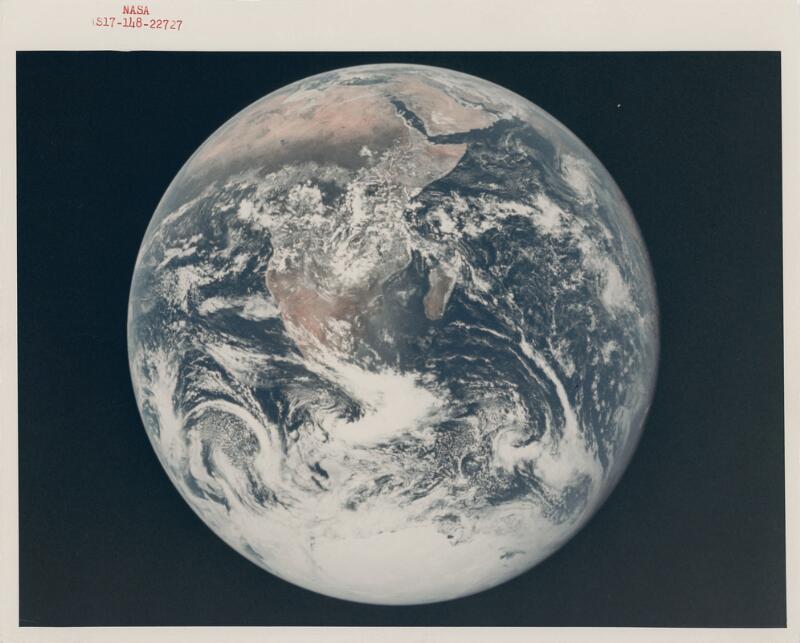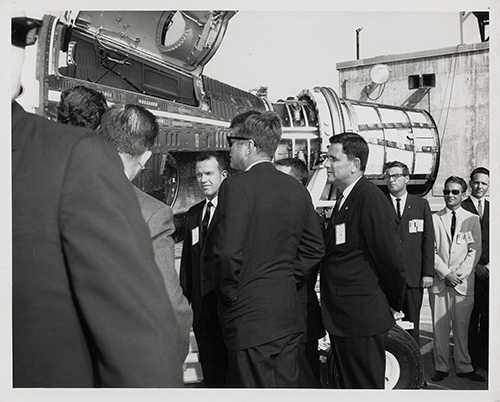Themed auction: The Golden Age of Space
Man has been fascinated by the Moon since the dawn of time, and the longing for the luminous celestial body has manifested itself in countless ways for thousands of years. But, up until 1969, the Moon was unattainable to man, except in his imagination, in art and in mythology. At a time when the world’s first Danish astronaut Andreas Mogensen is on his second mission to the International Space Station ISS, a large and fascinating collection of NASA photos depicting the unknown sides of the Moon, the astronauts and the men behind the Moon race, is now up for auction.
The space race of the mid-20th century offered many epochal moments, where bravery and technical breakthroughs went hand in hand to push the limits of human presence as far into space as possible. In the 1960s, for the first time ever in human history, the space race offered the opportunity to capture this new world, which no one had ever been close to, through photography. The Moon has been worshipped like a god by man for thousands of years. It has been ascribed mystical powers. It has been the subject of countless artists and celebrated in poetry and opera alike. The Moon has even been used by political regimes and empires. And the Moon has cast its light over both our romantic fantasies and the worst horror stories. Until the Moon Landing in 1969, the Moon was almost entirely the realm of the imagination. In Stanley Kubrick’s famous “2001: A Space Odyssey” (1968), the scientist Dr Floyd travelled into space on his way to the Clavius Moon Base. In reality, the astronaut Alan B. Shepard would become the first American in orbit in 1961.
Unique NASA Photographs Taken From Space
The auction features a number of unique and extremely rare photographs, and we can follow the lunar programme chronologically through the collection from start to finish. All of the photographs are originals, with just a limited number of them developed. They were taken as scientific documentation and have ended up becoming works of art. An extremely rare photograph from 1946 shows, for example, the first rocket – a V2 – to reach outer space when it was launched from White Sands, New Mexico on 10 May 1946, beginning the Moon race shortly after the end of World War II. The photograph is estimated at DKK 10,000–15,000. And, yes, NASA also sent off a test rocket manned by the chimpanzee Enos in November 1961. This meant that Apollo 11, with astronauts Buzz Aldrin and Neil Armstrong, could finally land on the moon in 1969. The very first photo of a human on the Moon was taken by the crew of Apollo 11. A total of 12 men walked on the Moon, the crew of Apollo 17 being the last to do so.
|
|
|
|
|
|
|
|
“The 60s, the world history and the entire Zeitgeist that have characterised our time shine through clearly in the photographs. Just the thought that these are original photographs taken by the astronauts themselves on the biggest mission of their lives and under immense challenges is enough to give you goosebumps. This is a unique, extremely exciting collection, put together by a passionate private collector who has an immense enthusiasm for this story, and who has contributed significantly to the telling of it.”
Peter BroeSpecialist in Photographs at Bruun Rasmussen
A First in Human History
The story of the race to the moon is also the story of one of the most exciting periods in American history, and of Presidents Dwight D. Eisenhower, John F. Kennedy and Lyndon B. Johnson. It is also an interesting coincidence that, in November 2023, it will be the 60th anniversary of the Dallas shooting of President Kennedy, one of the main forces behind the Apollo programme. Included in the auction are three photographs of the presidents, each visiting Cape Canaveral during their respective presidencies. The photograph of President Kennedy is of particular historical interest as his visit here took place on 16 November, just six days before his tragic death. The three historic photographs are estimated at DKK 6,000–8,000.
|
|
As the lunar capsules ventured further into space, the astronauts also managed to photograph the Earth in a way never before seen by mankind. James McDivitt, an astronaut on the Gemini IV launch in June 1965, took a stunning and symbolic photograph of the Cradle of Civilization, Egypt’s Nile Delta seen from outer space, which remained his own personal favourite. However, with the increasingly successful rocket launches and floating space capsules in orbit, the astronauts were charged with more risky tasks, which of course had to be photodocumented. Also included in the auction is the photo of the first man to walk in space, astronaut Ed White, photographed by James McDivitt in June 1965, which was featured on the cover of LIFE Magazine on 18 June 1965. On the same occasion, Ed White himself also took the first photograph ever taken in outer space.
|
|
Visual Cultural Heritage
The 1969 Moon Landing was an historic and spectacular event that was transmitted across the globe daily via images in all media of the day. The astronauts created a visual legacy that not only depicts the Moon but also captures some of the most significant technological achievements in human history. If you had to name one event in the 20th century that really made the headlines, it was the Moon Landing, which became the all-dominant cultural agenda of the world. The Moon Landing in 1969 blazed the trail for the future of space exploration. The Moon has become the springboard for missions that venture even further into the universe, and the numerous fascinating NASA photos have become a permanent part of humanity’s long history.
“When I looked up and saw the Earth coming up on this very stark, beat-up lunar horizon, an Earth that was the only color that we could see, a very fragile-looking Earth, a very delicate looking Earth, I was immediately almost overcome by the thought that we came all this way to the Moon, and yet the most significant thing we´re seeing is our own Home Planet, the Earth”.
William AndersAstronaut on the Apollo 8 mission, December 1968

For further information, please contact
|
|
Peter BroePeter BroeSpecialist / European Furniture & Rugs / København |






